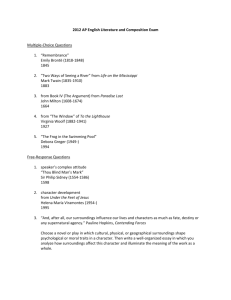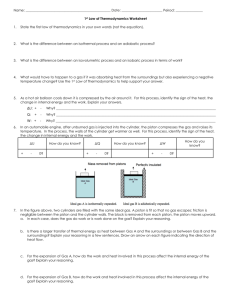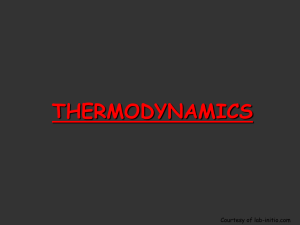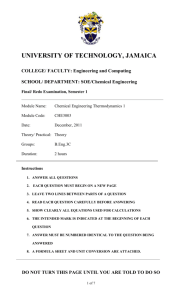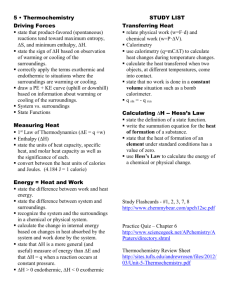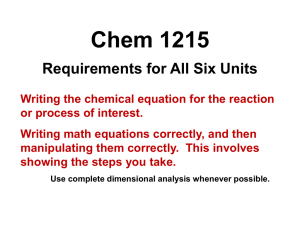First Law of Thermodynamics
advertisement
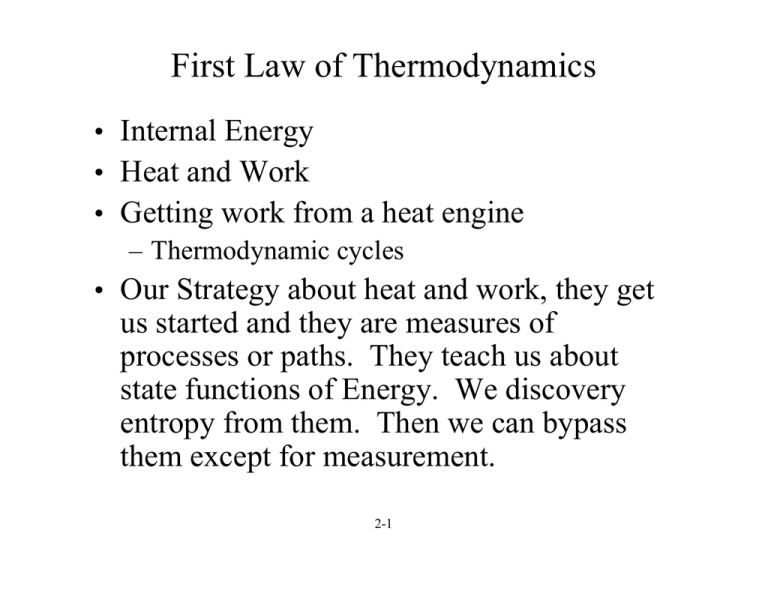
First Law of Thermodynamics • Internal Energy • Heat and Work • Getting work from a heat engine – Thermodynamic cycles • Our Strategy about heat and work, they get us started and they are measures of processes or paths. They teach us about state functions of Energy. We discovery entropy from them. Then we can bypass them except for measurement. 2-1 Internal Energy (U) U(V,T), U(P,T), or U(P,V), can take on a number of forms •Kinetic energy of molecules in system. •the potential energy of the constituents of the system relative to the center of mass of the system. For example, a crystal consisting of dipolar molecules will experience a change in its potential energy as an electric field is applied to the system. •the internal energy stored in the form of molecular vibration and rotation. •the internal energy stored in the form of chemical bonds that can be released through a chemical reaction. 2-1 First Law of Thermodynamics The First Law of Thermodynamics is based on our experience that energy can neither be created nor destroyed, if both the system and the surroundings are taken into account. The internal energy is U or Usystem. ΔU total = ΔU system + ΔU surroundings = 0 ΔU system = −ΔU surroundings U can be changed by either heat transfer or by work “flow” ΔU = q + w 2-2 Work: any quantity of energy that “flows” across the boundary between the system and surroundings that can be used to change the height of a mass in the surroundings. mass piston mass mechanical stops pi,Vi Initial State piston pf,Vf cylinder Final State cylinder •Work only appears during a change in state of the system and surroundings. Only energy, and not work, is associated with the initial and final states of the systems. 2-3 •Net effect of work is to change U in accordance with the First Law. If the only change in the surroundings is that a mass in the surroundings has been raised or lowered, work has flowed across the system between system and surroundings. •The quantity of work can be calculated from the change in potential energy of the mass, ΔE = w = Fh = mgh potential where g is the gravitational acceleration and h is the change in the height of the mass, m. •The sign convention for work is as follows. If the height of the mass in the surroundings is lowered, w is positive, and if the height is raised, w is negative. In short, w > 0 if ΔU > 0. It is common usage to say that if w is positive, work is done on the system by the surroundings. If w is negative, work is done by the system on the surroundings. 2-4 How to calculate work •Expansion work G G w = ∫ F • dl = − ∫∫∫ Pexternal dAdl = − ∫ Pexternal dV •Electrical work welectrical = q ⋅ φ = φ ⋅ I ⋅t mass mass pi,Vi H2 + φ Is the electrical potential, usually in Volts. O2 H2O - pi,Vf Initial State H2 + electrical generator - electrical generator mass mass 2-5 H2O O2 Final State EP2.1a) Calculate the work involved in expanding 20.0 L of an ideal gas to a final volume of 85.0 L against a constant external pressure of 2.50 bar. w = − ∫ Pexternal dV = − Pexternal (V f − Vi ) 105 Pa 10−6 m3 = −2.50bar ⋅ = −16.3 J (85.0 L − 20.0 L ) ⋅ bar L c) A current of 3.2 A is passed through a heating coil for 30 s. The electrical potential across the resistor is 14.5 V. Calculate the work done. w = ∫ φ dq = φ q = φ It = 14.5V ⋅ 3.2 A ⋅ 30 s = 1.39 kJ 1 Volt = 1 Joule/Coulomb 2-6 Heat is defined in thermodynamics as the quantity of energy that flows across the boundary between the system and surroundings because of a temperature difference between the system and the surroundings. •Heat is transitory, in that it only appears during a change in state of the system and surroundings. Only energy, and not heat, is associated with the initial and final states of the system and the surroundings. •The net effect of heat is to change the internal energy of the system and surroundings in accordance with the First Law. If the only change in the surroundings is a change in temperature of a reservoir, heat has flowed between system and surroundings. The quantity of heat that has flowed is directly proportional to the change in temperature of the reservoir. 2-7 •The sign convention for heat is as follows. If the temperature of the surroundings is lowered, q is positive, and if it is raised, q is negative. In short, q > 0 if ΔU > 0. It is common usage to say that if q is positive, heat is withdrawn from the surroundings and deposited in the system. If q is negative, heat is withdrawn from the system and deposited in the surroundings. Rest of universe Thermometers outer water bath Isolated composite system: Sealed reaction vessel Provides practical way to limit size of surroundings Heating coil inner water bath Touter = Tf 2-1 Tf Distinguishing work from heat electrical generator I Propane mass heating coil I Bunsen burner a b Two systems, I and II are enclosed in a rigid adiabatic enclosure. System I consists solely of the liquid in the beaker for each case. System II consists of everything else in the enclosure. Part a show a process in which the liquid is heated using a flame. Part b shows heating using a resistive coil through which an electrical current flows. 2-9 Surroundings are important • In both cases ΔU=0 (no work or heat was transferred in or out of the box.) • In the first one to do the energy balance, the change in chemical energy heated the water. 0 = ΔU = ΔU Chem + qWater • In the second one the loss of potential (I hate to call it work) became heat. 0 = ΔU = ΔU Mass + qWater 2-1 Heat capacity q dq / C = lim = ΔT → 0 T − T dT f i •C has the units J K-1 kg-1 in SI units. It is an extensive quantity. •Cp and Cv distinguish method of measurement; the first at constant pressure and the second at constant volume. w = φ ⋅ I ⋅t •Cm is an intensive quantity with the units J K-1 mol-1. •Convenient to measure q through electrical work •Numerical value depends on path between initial and final states. Most common are constant V or P. 2-12 Cp,m (J K-1mol-1) 60 50 40 30 20 10 solid 100 liquid 200 gas 300 400 Temperature (K) •CP,m for the solid rises rapidly at low T vibrations of the solid activated. •CP,m increases discontinuously as the solid melts to form a liquid because the liquid retains the local vibrational modes of the solid shifted to lower more accessible frequencies. •CP,m decreases discontinuously at the vaporization temperature because local vibrational modes in the liquid are converted to translations, which can’t take up 2-13 as much energy as vibrations. Once CP,m is known, q can be determined from ΔT of reservoir Tsys , f qP = ∫ CPsystem ( T ) dT = − Tsys ,i Tsurr , f ∫ CPsurroundings (T ) dT Tsurr ,i Water is a convenient choice of material for a heat bath in experiments because CP is nearly constant at the value 4.19 J g-1 K-1 or 75.4 J mol-1 K-1 over the range 0°C-100°C. From the idea of the equipartition of energy: each mode that can access the energy gets 1 R added to the heat capacity. For water 2 For Cv: We have 3 rotational and 3 translational degrees of freedom and 3 vibrational degrees of freedom. This gives at most 3+3+2*3=12 modes, or 48 J mol-12-14K-1 CP,m > CV,m for gases w For ideal gas mass CP − CV = nR or piston mass piston q pi,Ti pi,Tf cylinder cylinder Initial State Constant Pressure Heating Final State Vi,Ti Vi,Tf Initial State Final State Constant Volume Heating 2-15 CP ,m − CV ,m = R State functions and path functions Change particle speed following the sequence v1 → v2 → v3 → v4. 1 1 1 1 1 1 ΔEkinetic = ⎛⎜ mv 22 − mv12 ⎞⎟ + ⎛⎜ mv 32 − mv 22 ⎞⎟ + ⎛⎜ mv 42 − mv 32 ⎞⎟ 2 2 2 ⎝2 ⎠ ⎝2 ⎠ ⎝2 ⎠ 1 2 1 2⎞ ⎛ = ⎜ mv 4 − mv 1 ⎟ 2 ⎝2 ⎠ f ΔU = ∫ dU = U f − U i i v∫ dU = U f −U f = 0 Condition defines state function U (or any state function) can be expressed as an infinitesimal quantity, dU, that when integrated, depends only on the initial and final states. dU is called an exact differential. Is w a state function? mass piston mechanical stop p1,V1,T1 mass mass piston piston p2,V2,T2 p ,V2,T3 3 T3 T3 cylinder T3 Initial State w = − Pexternal ΔV Intermediate State Final State T1 < T2 < T3 Repeat process with different masses. For each path P1,T1 → P3,T3 therefore ΔU same Work different for each path. Therefore, work is a path function, not a state function. Assume in all cases that Pext > Pint so compression happens. For different masses2-17 different amount of work but system change is the same. Is q a state function? If w is a path function and U is a state function, q = ΔU-w must be a path function. mass piston mechanical stop p1,V1,T1 mass mass piston piston p2,V2,T2 p ,V2,T3 3 f ∫ i Δq ≠ dq / ≠ q f − qi cylinder T3 Initial State T3 T3 Intermediate State 2-18 Final State f ∫ i Δw ≠ dw / ≠ w f − wi Thermodynamics can only Quasi-static process be applied to systems in internal equilibrium, and a 1000 requirement for 800 equilibrium is that the 600 T(K) 400 overall rate of change of 200 all processes such as 6 3×10 diffusion or chemical reaction is zero. How do 6 2×10 P(Pa) i we reconcile these statements with our 6 1×10 f calculations of q, w, and ΔU associated with 0 0.0125 0.01 0.00750.0050.0025 processes in which there is a macroscopic change in the system? 2-19 Reversible process: an infinitesimal opposing change in the variable that drives the process causes a reversal in the direction of the process. Infinitesimal temperature changes in a 2 phase gas – liquid system at the boiling temperature pulley 1 kg 1 kg 2-20 Irreversible process: a large opposing change in the variable that drives the process is needed to cause a reversal in the direction of the process. A mechanical stop holding a piston is removed. As a result, a gas is compressed. mass piston mass mechanical stops pi,Vi Initial State cylinder piston pf,Vf cylinder 2-21 Final State Calculating work in an irreversible process at constant Pexternal T, P2, V1 → T, P2, V2 , P2 < P1 q1 > 0 Initially, Pexternal = P1 , reduce to Pexternal = P2, increase again to Pexternal = P1 Keep the temperature constant throughout the process. Indicator diagram w > 0, q 0 w > 0, q < 0 T, P1, V2 → T, P1,V1 q2 < 0 ΔU = 0 because cyclic process wtotal = − P2 (V2 − V1 ) − P1 (V1 − V2 ) = − ( P2 − P1 )(V2 − V1 ) > 0 Calculating reversible work (IG) wexp ansion dV V2 = − ∫ Pexternal dV = − ∫ PdV = − nRT ∫ = − nRT ln V V1 For reversible cyclic process ΔU=w=q= 0 2-23 P P V P P V P V V P V V For compression, wreversible < wirreversible For expansion, wreversible < wirreversible The maximum work that can be extracted (w<0) from a process between the same initial and final states is obtained under reversible conditions. The meaning of 2-24 revesible vs irreversible path. Determining ΔU The First law states that ΔU = q + w . Imagine that the process is carried out under constant volume conditions and that non-expansion work is not possible. Because under these conditions w = − P dV = 0 ∫ external ΔU = qV Simple example: Heat a gas in a steel cylinder. The heat is directly related to the increase in internal energy of the gas. 2-25 Introducing Enthalpy, a new State Function What does the First Law look like under reversible and constant pressure conditions? ΔP = 0 By constant pressure we mean that the external pressure is kept constant and the internal pressure always equals it; the volume of the box may readjust during a transformation. Pex = P / P − Pex dV = dq / P − PdV dU = dq f ∫ dU = U i (U f f / P − ∫ PdV = qP − ( Pf V f − Pf Vi ) − U i = ∫ dq + Pf V f ) − (U i + Pf Vi ) = qP If we define a new state function: H ≡ U + PV 2-26 Then it follows for processes carried out at constant P: ΔH = q P Calculating q, w, ΔU, and ΔH for Processes Involving Ideal Gases In order to describe a fixed amount of an ideal gas (i.e. n is constant), the values of two of the variables P, V, and T must be known. Is this also true for ΔU for processes involving ideal gases? ΔU = qV = CV ( T f − Ti ) ΔH = qP = CP ( T f − Ti ) Because U(H) is a function of T only for an ideal gas, this equation is also valid for processes involving ideal gases in which V is not constant. Therefore, if we know CV(CP), T1 and T2, we can calculate ΔU(ΔH), regardless of the path between the initial and final states. 2-27 Further important relations for ideal gas CP − CV = nR w = − Pexternal (V f − Vi ) Irreversible P-V work at constant P Vf dV w = − nRT ∫ = − nRT ln V Vi 2-28 Reversible P-V work Example Problem 2.5 A system containing 2.50 mol of an ideal gas for which CV,m = 20.79 J mol-1K-1 is taken through the cycle indicated below in the direction indicated by the arrows. The curved path corresponds to PV = nRT , where T = T1 = T3 16.6 bar, 1.00 L 15.0 16.6 bar, 25.0 L 1 2 12.5 10.0 P(bar) 7.5 5.0 3 2.5 0 0.665 bar, 25.0 L 5 10 15 20 V(L) 2-29 25 a) Calculate q, w, and ΔU and ΔH for each segment, and for the cycle. b) Calculate q, w, and ΔU and ΔH for each segment, and for the cycle in which the direction of each process is reversed. Segment 1→ 2 CV ( PV 2 2 − PV 1 1) nR 2.50 mol x 20.79 J mol −1 K −1 = (16.6 bar x 25.0 L − 16.6 bar x 1.00 L ) −1 −1 2.50 mol x .08314 Lbar K mol = 99.6 kJ 105 N m −2 w = − Pexternal (V2 − V1 ) = 16.6 bar x x ( 25.0 x 10−3 m 3 − 1.00 x 10−3 m 3 ) = −39.8 kJ bar ΔU1→2 = CV (T2 − T1 ) = q = ΔU − w = 99.6kJ + 39.8kJ = 139.4kJ PV 16.6 bar x 25.0 L 3 2 2 T2 = 2.00 x 10 K = = −1 −1 nR 2.50 mol x .08314 Lbar K mol ΔH1→2 = ΔU1→2 + Δ ( PV ) = ΔU1→2 + nR (T2 − T1 ) = 99.6 x 103 J + 2.5 mol x 8.314 J mol −1K −1 x ( 2000 K − 79.9 K ) = 139 kJ 2-30 Segment 2→ 3 w = 0 because ΔV = 0 CV ( PV 3 3 − PV 2 2) nR 2.50 mol x 20.79 J mol −1 K −1 = ( 0.665 bar x 25.0 L − 16.6 bar x 25.0 L ) = −99.6kJ −1 −1 2.50 x .08314 Lbar K mol ΔU 2→3 = q2→3 = CV (T3 − T2 ) = ΔH 2→3 = −ΔH 1→2 because T3 = T1 2-31 Segment 3 → 1 ΔU 3→1 = 0 and ΔH 3→1 = 0 because ΔT = 0 PV 16.6 bar x 1.00 L 3 3 = = 79.9 K T3 = −1 −1 nR 2.50 mol x 0.08314 Lbar mol K V1 w3→1 = −nRT ln V3 1.00 = −2.50mol x 8.314 J mol K x 79.9 K ln = 5.35kJ 25.0 −1 −1 2-32 Path q ΔU w ΔH 1→2 139.4 kJ -39.8 kJ 99.6 kJ 139.4 kJ 2→3 -99.6 kJ 0 -99.6 kJ -139.4 kJ 3→1 -5.35 kJ 5.35 kJ 0 0 cycle 34.5 kJ -34.5 kJ 0 0 2-33 Reversible Adiabatic Expansion and Compression of an Ideal Gas ΔU = w or CV dT = − Pexternal dV dV dT dV or equivalently, CV CV dT = − nRT = − nR V T V Tf Vf dT dV Tf Vf ∫T CV T = −nR V∫ V CV ln T = −nR ln V i i i i 1−γ Tf ⎛ Vf ⎞ ⎛ Tf ⎞ ⎛Vf ⎞ =⎜ ⎟ ln ⎜ ⎟ = − (γ − 1) ln ⎜ ⎟ or equivalently, Ti ⎝ Vi ⎠ ⎝ Ti ⎠ ⎝ Vi ⎠ 2-34 CP ,m γ= CV ,m Tf Ti = Pf V f PV i i γ γ PV = P V i i f f Adiabatic PV = R ⋅ 300 K Isothermal 2-35
